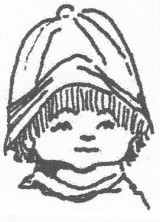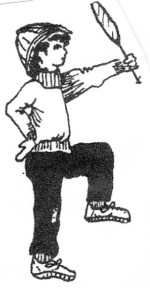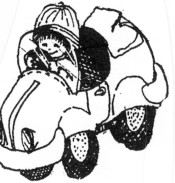The Spirit’s Body
A “scientific” description of how spirit becomes flesh
I wrote the story of Eno as if it were science fiction, but it is a fairly accurate scientific – as we commonly think of that word – description of how spirit – that’s a metaphor, too, for some kind of life force – generates a physical structure for itself. .
When we talk about how little babies get started [conception, the physical stages of development – arms, legs, lungs, heart – and mental development – brain, nervous system, mind – we have to understand, reader, that those are words, metaphors, about what’s actually going on. We’re used to this language. But when we penetrate beneath this overlay of language, we discover something mysterious, something magical going on. The raw material of an organism becomes a human being through a genetic code system, more like the binary zeros and ones that lie behind the internet than the biological metaphors we commonly use.
So if you have any interest at all about who that person in the mirror is, you have to go down to and beyond the genetic code.
[A man pauses from shaving one morning and looks thoughtfully at the face in the mirror and asks, “Who are you?” The image replies, “Who wants to know?”]
If you are very quiet and open, you may get a feel for who wants to know and even come fact-to-face with this great and marvelous mystery.
Trailing Clouds of Glory
Our birth is but a sleep and a forgetting;
The Soul that rises with us, our life’s Star,
Hath had elsewhere its setting
And cometh from afar;
Not in entire forgetfulness,
And not in utter nakedness,
But trailing clouds of glory do we come
–Wordsworth
Eno could see himself in no mirror, however brightly polished; no words could define him, however cunningly shaped and arranged. Though he knew that a reflection referred to something that was Eno, it was also not him at all. Whatever he said he was, he was, and yet he wasn’t at all. What, who, when was he? Was it really he who asked these questions? Was there even a question to ask? Propelled forward as he was, was there time to ask a question? WHAT WAS GOING ON?
Suddenly he emerged on a strange, totally unfamiliar planet, an Energy and Atom Recycler through Temporal Holography (“Earth”), knowing neither who he was nor how he got there. Had some angry god banished him to this chaos? Had he been selected as a special intelligence agent to probe this alien soil light-years from home, to somehow master it and return with his cache to the data banks of a nonphysical world he could not at present even remember? Nothing made sense. Sense itself did not make sense. Sense had something to do with stimuli and his responses, and, out of awareness, he grasped that he was equipped with nerve endings that were nothing more than tools he was using to collect stimuli and figure out this puzzle. He knew that nerve endings themselves were not Eno. And yet, perhaps . . . If he had been sent to probe this world, to study and to understand it truly, then naturally he could not “know” it merely by observing. His intelligence was not specialized to observe in the first place. If there were beings in this planet, he would have to adapt his intelligence to something approximating the tools they presumably possessed. To understand them, he would have to be one of them—completely; he must not even know that he was a spy. Possibly those who sent him might monitor the process, perhaps tag him somehow so that they could retrieve him at the optimum moment. But tagging would not really be necessary because he would always be obvious to his own kind in their own structuring system.
RECONNAISSANCE
I am not I.
I am this one
walking beside me whom I do not see
–Juan Ramón Jiménez
Possibly, then, Eno’s identity was out in the open, but neither the target race nor he himself was capable of sensing it, as though they were tuned to a radio frequency that couldn’t pick him up even though his waves were all about them. He thus might penetrate the target race, taking on more and more of their characteristics until the crucial moment when he would be yanked home for analysis. But that was only one of the limitless possibilities of the riddle of his essence.
Eno was dimensionless. He did not belong to a place. He did not belong to a time. He had no length, no breadth, no thickness. Any form he achieved might seem to alter, but Eno himself always had been and always would be. He had entered this world through a crack in the time shield. One moment he was nowhere and the next he was physical, as though someone had twisted a kaleidoscope and Eno was the image produced.
 It was not so much a matter of travel as it was a matter of coming into focus or of being translated to another radio frequency. Suddenly, so it seemed, there was a new bias toward form and structure with a thrust toward definition, toward becoming finite. This urgency to define necessitated senses. He began specializing his nerve endings and developed a complete sensorium. Through its agency he became, or seemed to become, concrete. Senses were a means of differentiating, of separating, of setting up distinctions, billions of them, every particle separated from every other by a sensing structure whose nature it was to see isolates. This planet existed through differentiation (“this is different from that”), through the emergence of things, the separating of one thing from another—and putting them together as well! Eno was an emergencee, emerging from the galactic “mother” through the uterus of what his senses identified as the “human” form.
It was not so much a matter of travel as it was a matter of coming into focus or of being translated to another radio frequency. Suddenly, so it seemed, there was a new bias toward form and structure with a thrust toward definition, toward becoming finite. This urgency to define necessitated senses. He began specializing his nerve endings and developed a complete sensorium. Through its agency he became, or seemed to become, concrete. Senses were a means of differentiating, of separating, of setting up distinctions, billions of them, every particle separated from every other by a sensing structure whose nature it was to see isolates. This planet existed through differentiation (“this is different from that”), through the emergence of things, the separating of one thing from another—and putting them together as well! Eno was an emergencee, emerging from the galactic “mother” through the uterus of what his senses identified as the “human” form.
 Immediately, he began his research. Because he did not even know he was a spy, he investigated automatically, to begin with. He sharpened his Early Yield External Sensors (“eyes”). Out of the gray blur, he forced entities to emerge, identifiable separations from the vast general jumble. From a few trifling particulars, he deduced general laws. Falling was dangerous.
Immediately, he began his research. Because he did not even know he was a spy, he investigated automatically, to begin with. He sharpened his Early Yield External Sensors (“eyes”). Out of the gray blur, he forced entities to emerge, identifiable separations from the vast general jumble. From a few trifling particulars, he deduced general laws. Falling was dangerous. Eating was desirable. These were nerve-ending “concepts” felt but not intellectually known. He identified a nippled nutrient sack and grew himself flesh and bones, perfect camouflage for a dimensionless fellow. He became one with time and space. Every planet day new floods of data poured into his Master Integrator of Nervous Data (“mind”), where he automatically began to create a time-space first approximation of his surroundings, his own Boundary Of Dimensional Yin-yang (“body”) being part of the structure. And each dis … covery hid him from himself more and more completely! Nonentity had merged with entity. The investigation had begun, and no one suspected a thing. Birth was so ordinary, just another emergencee.
Eating was desirable. These were nerve-ending “concepts” felt but not intellectually known. He identified a nippled nutrient sack and grew himself flesh and bones, perfect camouflage for a dimensionless fellow. He became one with time and space. Every planet day new floods of data poured into his Master Integrator of Nervous Data (“mind”), where he automatically began to create a time-space first approximation of his surroundings, his own Boundary Of Dimensional Yin-yang (“body”) being part of the structure. And each dis … covery hid him from himself more and more completely! Nonentity had merged with entity. The investigation had begun, and no one suspected a thing. Birth was so ordinary, just another emergencee.
In the Realm of the Senses
For Eno the validity of the parts of the sensorium (nose, taste buds, fingertips) was unquestioned. That which worked was true. If one thing failed, he tried another and didn’t think about how real or “true” it was. Only that which promoted his own toehold on the planet was important. Out of the sensorium grew a knowledge of the Synthesis of the Entire Life Force (“self”). He had to be totally “self”ish or become overwhelmed by the great wash of “things” pressing against the flimsy dikes of his new flesh. Eno was not conscious of the dangers. His flesh took charge, touched, and assimilated. He did not know this knowledge, this “nourishment,” was his lifeline. His body did the work, and for him it was child’s play! Literally. He laughed. He fondled, tasted,smelled, played constantly with sounds he could make with his tongue, air, oral cavities. He developed depth perception. He sensed warmth and burning, coolness and the pain of ice. Locomotion became vital. He grew himself “muscles” and forced himself to master Articulated Regulators of Manipulatory Skill (“arms”) and Locomotor Extensions against Gravitational Supremacy (“legs”). He had become some thing, an entity, but his mind did not know it.
He laughed. He fondled, tasted,smelled, played constantly with sounds he could make with his tongue, air, oral cavities. He developed depth perception. He sensed warmth and burning, coolness and the pain of ice. Locomotion became vital. He grew himself “muscles” and forced himself to master Articulated Regulators of Manipulatory Skill (“arms”) and Locomotor Extensions against Gravitational Supremacy (“legs”). He had become some thing, an entity, but his mind did not know it.
If there were watchers, they would have known the immensity of the experiment. The spy Eno was embarked on frighteningly dangerous reconnaissance in complete ignorance. He was hypnotized by the reality of appearance. Each planet day it appeared that he brushed aside another veil and disclosed more and more facets of this shimmering planet. It was all a matter of interstices, of course, intersections of electromagnetic force fields, but within the perception centers of this alien structure (his body) appearance was the only reality. Finally, in the third year of his new time sense, Eno made one of the most startling of his discoveries: his own identity. He had been busy dis … covering things out there; he now dis … covered his self. “I am!” he thought. This discovery launched him toward the next leg of his journey.
During the first stage of his planetary probe, when his senses automatically fondled the world so that he “knew” it on his nerve endings, Eno’s experiments with sound had paid off in a magical assortment of talismans, Wave Ordinates Revealing Dharma Signs (“words”) and “concepts” capable of giving him balance on this slippery sensate flow, a surfboard for riding out the waves. He could shape air and call nourishment to his lips for energy replenishment. He began to capture the world in this symbolic network. He mastered the linguistic code nearest at hand. The power it gave him over his perceived world was amazing. He spent most of his waking hours playing with and perfecting this new instrument. One network of intersecting concepts he identified as his self That bundle of ideas had been given the code name Robert, but of course that referred only to the space-time mask Eno wore. Robert referred to the energy system of bones and kidneys, nose and fingernails. To be was to be physical. Was that the solution to his identity? Was Eno really physical? When he became defined, when he became Robert, did he cease to be Eno? Did nonentity cease when entity emerged? Were being and nonbeing one thing?
His parts were at once instruments for knowing reality and reality itself. For one could not be without the other. This new magical “language” was a probe for exploring, but it created that which was explored as well. The tool shaped the craftsman. Just as his new “eyes” had filtered the continuum of color and presented his mind a “reality” of only one sector of the spectrum, what he perceived through the language tool was limited by the tool. Language pinpointed the intersection of things, showed where the connections were, but it also determined what would be considered to intersect. It was a structure system that gave him a handhold on the planet, but was it the planet, or were there many planets superimposed on each other? If Eno had entered the planet as a tree, it would have been tree “reality” he would have experienced: different sensors, different filtering, different planet. What was really going on?
This entire displacement stage, the “What if .. . . ?” stage, exactly paralled that in which his senses and muscles had identified and shaped a world for him. His mental”senses” now probed this world. He formed relationships and the relationships were his reality. For him, all that he noticed was all that there was. Though he used these processes well, they were as automatic as those of his earlier stages. The eye could not see itself. The planetary searcher had done his job perhaps too well, for he had entered into the life of the planet and assumed its characteristics completely. But was he air and water, emotions, sentiment, intersections of force fields? At this stage the questions did not occur. And without the question he could not discover his self, the Eno, and would continue imagining himself to be merely the surface being Robert. As long as he stayed within the psychophysical structure system he had defined, the combined mind-body package, the question could not occur to him. He felt he had completed his search. He was mistaken, of course, in fact about as far from the answer as he could get; and if he stopped there, the probe would have failed. But he did not know this. He felt he had finished, and he grew listless and depressed. Without something firing his mind and body, he felt pointless. Was he to sit out his remaining planet years working crossword puzzles and drinking beer? The planet, the lustrous jewel that had so fascinated him, now seemed more and more tarnished and drab. There was nothing to do, nothing to integrate. The fires burned low; the energy construct Eno began to decompose into nothingness. Still he lingered, pointlessly.
Finally, the probe almost burned out, reduced to reruns and insomnia, Eno found himself thurst toward a new genesis and discovered that the end was only a second approximation.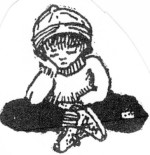 Boredom and chance (mere accidents or part of a calculated design?) hurled him into a totally foreign region of the planet. He went on an adventure. Does it matter how it came about, where he went, with whom, or why? Such “accidents” do happen, and for some planetary explorers a new birth occurs. Throbbing through his body-mind came the old question: WHAT WAS GOING ON? His entire being responded.
Boredom and chance (mere accidents or part of a calculated design?) hurled him into a totally foreign region of the planet. He went on an adventure. Does it matter how it came about, where he went, with whom, or why? Such “accidents” do happen, and for some planetary explorers a new birth occurs. Throbbing through his body-mind came the old question: WHAT WAS GOING ON? His entire being responded.
Nerve endings tingled with new data: His mind lurched into gear. In this far region of the globe he walked among beings of his own “human” class who appeared to experience a different reality! Does it matter whether they were aborigines or university professors? They did not see as Eno saw or as the others of his party saw. The beings among whom they now found themselves selected other things to notice, and they summed them up strangely. One way for Eno to cope with this peculiar world was to translate it into terms of his old reality and force it to fit into his old construct. That was the common way out of the dilemma. Several of those in his party chose to do that. But as someone has said, translations are like the back side of a tapestry, and Eno preferred the front. If their reality was fixed up to fit his, it was no longer their reality. Later he would even have to question this preference. Why wasn’t everyone sparked by the same drive to penetrate this new construct? Why did some cling to the old pictures.
At the moment, however, something more important occupied his thoughts: Everything he “understood” had been assimilated outside of his conscious awareness. That was a shock. He had had his “eyes” open, his “mind” open, but within a closed-off system!— his group’s private, isolated world. How did he know that any of it was true? This brush with a foreign reality forced the likelihood that his reality was no more accurate than theirs. Wherever the truth might be, it would have to encompass all realities. That meant eight billion human realities, tree realities, whale realities, rock realities, galaxy realities. Following the method he had used for his first two approximations of reality, he began with himself, with his own picture of reality. He began probing his own self-construct. He had constructed reality twice, through his sensors and symbolically; now he must go over the same ground again. What was going on? His picture, his awareness, was based on his sense perceptions, sentience, the capacity to sense. But these were specialized devices for filtering out very restricted kinds and amounts of information. ‘Visions of infrared and ultraviolet, fourth and fifth dimensions, base 2 and base 12 in the numbering systems, came now to shake the basis of his world. Now the entire perception network, the senses, and the mind itself must be questioned. He set out without a map along an unknown road.
How did he know that any of it was true? This brush with a foreign reality forced the likelihood that his reality was no more accurate than theirs. Wherever the truth might be, it would have to encompass all realities. That meant eight billion human realities, tree realities, whale realities, rock realities, galaxy realities. Following the method he had used for his first two approximations of reality, he began with himself, with his own picture of reality. He began probing his own self-construct. He had constructed reality twice, through his sensors and symbolically; now he must go over the same ground again. What was going on? His picture, his awareness, was based on his sense perceptions, sentience, the capacity to sense. But these were specialized devices for filtering out very restricted kinds and amounts of information. ‘Visions of infrared and ultraviolet, fourth and fifth dimensions, base 2 and base 12 in the numbering systems, came now to shake the basis of his world. Now the entire perception network, the senses, and the mind itself must be questioned. He set out without a map along an unknown road.
Down an unknown road, but perhaps not without a map. For Eno’s investigation of his own sensors, of what had been called sentience, opened the possibility that his search was not so random after all. There now seemed to be some pattern to his behavior coming from deep within. He was not driftwood but a homing device. The gathering of data by the senses was not random but controlled, purposeful, intelligent. The body did not merely collect data as though it were a grain elevator or a museum. He saw that he put things together, that he integrated, organized them into a framework, a system, that information was mere raw material. Even the smallest Fixing And Cross-referencing Trace (“fact”) could exist only by interrelating with all other “Facts.” The framework was already operating in his own mind. That particular framework functioned well in human entities but would not suit a cat or a tree. They experienced their own realities.
It appeared, then, that a deep structure directed his movements toward a physical fulfillment of its potential. Even the narrowest “fact” (2 + 2) was a general concept. The slightest bit of information was the result of a bunching process. There had to be within him already a blueprint for quantities before 2 + 2 could trigger his mind toward the general idea of 4. The process seemed to work like a hologram, the three-dimensional laser picture—any part of which could trigger the whole. Tape a laser picture, cut off any part of it, project it, and the whole image would appear. Likewise, the tiny fact of 2 + 2 was impossible to contemplate as an isolate, for it was embedded in a complete interrelated system. When Eno encountered such a “fact,” he had to step back far enough and toy with it enough so that the system in which 2 + 2 was possible came into focus—very much the way he had come into focus at the beginning of his planet probe. And the numbering system itself was not isolated from the rest of the picture either, for by examining the situation in which 2 + 2 was possible, he could begin to grasp the entire sentient process, the whole process of differentiating and integrating, of noticing differences and of putting things together. Just as a point entered reality through the intersecting of lines, any bit of data gained its existence through the intersecting of concepts. Thus, an accumulation of bits resulted in the concept of 1, and that 1 could only exist as a part of a picture of reality, as part of a complete system.
So Eno began to turn his investigation away from the nerve endings inward toward the blueprint. Sensing was evidence that something inside was going on. It seemed that the instant the kaleidoscope turned and he entered into matter, became flesh, the impulse to generate a “human” nature was already there, and with adequate nourishment he would flesh out and fulfill that nature.
Now he began to guess an answer to one of his major questions. He had discovered that his senses were inaccurate and extremely weak. He could not see an atom; his temperature range was very narrow. How could his senses ever yield a true version of reality? When he apprehended (see prehensile) that the picture he was looking for was inside him, already there, sensing and perceiving took on new meaning. Sensors did not have to be absolutely accurate, for, if they triggered the right “nodes,” Eno within himself would make up for any flaws and would activate his “nature” himself internally. He now saw nerve endings as catalysts. He knew that the operation did not take place out there. For this
surgeon to know where to operate, crude indicators were sufficient; mere traces would suffice.
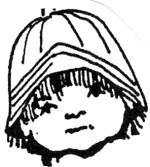 When Eno’s research took this turn, he found himself in trouble with other “humans.” That they were standing on a planet and that they were made up of atoms that were made up of space seemed irrelevant. “I’m sitting here on what I think is a chair, and that’s enough. I don’t have to go delving into the source of such ideas.” To Eno, when one looked at himself so narrowly, he behaved narrowly and felt narrow. Because he did not see the world in its larger framework, such a person would always feel isolated and alone, would always be mis … taking his situation. For Eno, though the pain of experience was no less severe, indeed was even more intense, the large frame gave the struggle character. It was not wantonly absurd. As a Cosmos Held In Limited Dimension (“child”) he had felt that the world he perceived did not exist for other people and had felt isolated and frustrated. It was only by following through till he could connect his perception to a total world, an inner world, that he could fulfill himself. The limited concept would likely have culminated in disaster, a grain wasting away in barren soil.
When Eno’s research took this turn, he found himself in trouble with other “humans.” That they were standing on a planet and that they were made up of atoms that were made up of space seemed irrelevant. “I’m sitting here on what I think is a chair, and that’s enough. I don’t have to go delving into the source of such ideas.” To Eno, when one looked at himself so narrowly, he behaved narrowly and felt narrow. Because he did not see the world in its larger framework, such a person would always feel isolated and alone, would always be mis … taking his situation. For Eno, though the pain of experience was no less severe, indeed was even more intense, the large frame gave the struggle character. It was not wantonly absurd. As a Cosmos Held In Limited Dimension (“child”) he had felt that the world he perceived did not exist for other people and had felt isolated and frustrated. It was only by following through till he could connect his perception to a total world, an inner world, that he could fulfill himself. The limited concept would likely have culminated in disaster, a grain wasting away in barren soil.
To say that he was sitting in a chair was the most incredible leap of faith that anyone could imagine. One was isolated within a limited and faulty sensing system; every thing was composed of fictional qualities.  One knew nothing. Yet one “sat in a chair,” a miracle of synthesis. That should have convinced the others. They had leaped to such conclusions countless times. But they seemed blind to their own sleight of hand.
One knew nothing. Yet one “sat in a chair,” a miracle of synthesis. That should have convinced the others. They had leaped to such conclusions countless times. But they seemed blind to their own sleight of hand.
In Eno’s investigation there had been paintings, myths, mandalas, figures of speech, the whole structure of language—all pointing to what? He looked out and said, “That a bush, and that’s Eno, and that’s God.” It appeared that in this fashion he was classifying and organizing the world, but that was not the case at all. What he was doing was illuminating his own self. When Eno “became,” there was a thrust within him; the pattern was already there. It was like the genetic code, but it was a nonphysical thing. It seemed to be saying to him, “Eno, you’re a kind of creature composed of categories and patterns, and what you have to do is fill them in, to realize them.” Thus, his fingers might crudely sense and report some shape. That signal, coupled with his mind, would yield “desk.” It didn’t matter that the signal was crude. All he needed was something to activate what was already there, to bring patterns into focus. For it was an internal world he was illuminating. It was the intuitive leaps his mind took that engaged and excited him; he would use anything he could get, however crude. He was a thrust toward lucidity and that thrust could be triggered by dreams or . . . anything. Those leaps were not based on physical phenomena; it was the other way around. One did not have to experience every single particle of the physical world.
But that led to another question. If traces were sufficient, what need was there for sharpening or tuning his senses? He knew the answer: For triggering to occur, experience had to be sharp, intense. Though the catalyst could be rough, it had to penetrate. Even though the senses were not the answer in themselves, he did have to send out sharply in order to receive sharply. It had to be a vigorous thrust. If he was not intensely fooling around, the insights, the leaps of lucidity would not happen.
And language was part of (or the same as) all the things he had been thinking of. Language (metaphor) could not be less vigorous or less honed than the physical network. Sharpening up metaphors was like sharpening up the senses. (Were not the senses metaphors themselves?) Sharpening up one’s use of language was like finding a way to trigger reality
Synapsis.


